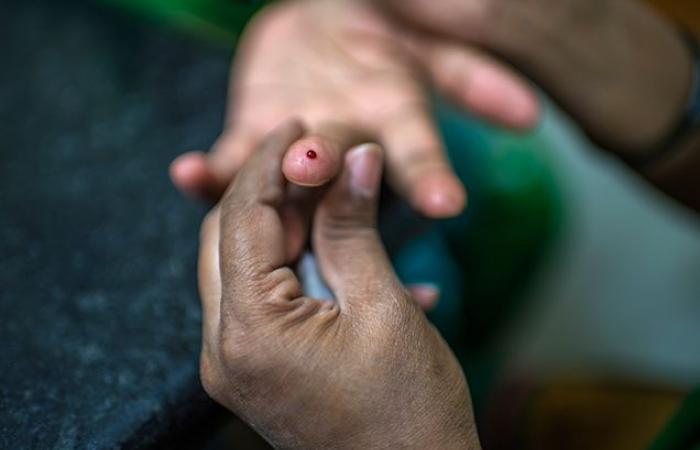Key facts
- The number of people with diabetes has increased from 200 million in 1990 to 830 million in 2022. The prevalence of diabetes has increased more rapidly in low- and middle-income countries than in high-income countries.
- More than half of people with diabetes did not take treatment in 2022. Diabetes treatment coverage was lowest in low- and middle-income countries.
- Diabetes can lead to blindness, kidney failure, myocardial infarction, stroke and lower limb amputation.
- In 2021, diabetes and diabetic kidney disease caused more than two million deaths. Additionally, approximately 11% of cardiovascular deaths were due to hyperglycemia.
- Having a healthy diet, regular physical activity, a normal weight and avoiding tobacco consumption are all ways to prevent or delay the onset of type 2 diabetes.
- A healthy diet, physical activity, medications, regular screening and management of complications make it possible to treat diabetes and avoid or delay the consequences it can have.
Overview
Diabetes is a chronic disease that occurs when the pancreas does not produce enough insulin or when the body is not able to use the insulin it produces effectively. Insulin is a hormone that regulates blood sugar levels. Hyperglycemia (high blood sugar) is a common effect of uncontrolled diabetes that, over time, causes serious damage to many parts of the body, especially nerves and blood vessels.
In 2022, 14% of people aged 18 had diabetes, compared to 7% in 1990. More than half (59%) of diabetics aged 30 or over were not taking any treatment in 2022. This is within the low- and middle-income countries had the lowest diabetes treatment coverage.
In 2021, diabetes was the direct cause of 1.6 million deaths and 47% of diabetes deaths occurred before the age of 70. In addition, another 530,000 deaths from kidney disease were caused by diabetes, and hyperglycemia accounts for approximately 11% of deaths from cardiovascular disease. (1).
Since 2000, mortality rates from diabetes have increased. In contrast, the probability of dying from one of the four main types of noncommunicable diseases (cardiovascular diseases, cancers, chronic respiratory conditions or diabetes) between the ages of 30 and 70 fell by 20% globally between 2000 and 2019.
Symptoms
Symptoms of diabetes can appear suddenly. In type 2 diabetes, symptoms may be mild and may not be noticed for several years.
The symptoms of diabetes are:
- intense thirst
- need to urinate more often than usual
- blurred vision
- feeling tired
- weight loss
Over time, diabetes can cause vascular damage to the heart, eyes, kidneys and nerves.
Diabetics are at greater risk of health problems such as myocardial infarction, stroke or kidney failure.
Diabetes can cause vascular damage to the eyes and cause permanent blindness.
Many diabetics have foot problems due to nerve damage and poor blood circulation. Foot ulcers may occur and require amputation.
Type 1 diabetes
Type 1 diabetes (formerly called insulin-dependent or juvenile diabetes) is characterized by insufficient production of insulin, which must be administered daily. In 2017, nine million people, the majority of whom lived in high-income countries, had type 1 diabetes. The cause of type 1 diabetes is not known and, according to current knowledge, it does not There is no means of prevention.
Type 2 diabetes
Type 2 diabetes changes the way the body uses glucose for energy. The body is unable to use insulin properly, which can lead to high blood sugar if left untreated.
Over time, type 2 diabetes can cause serious damage, especially to nerves and blood vessels.
Type 2 diabetes is often preventable. Being overweight, lack of exercise and a genetic predisposition contribute to the onset of type 2 diabetes.
It is important to diagnose early to avoid the worst effects of type 2 diabetes. The best way to detect diabetes early is to see a healthcare provider for regular checkups and blood tests.
The symptoms of type 2 diabetes may be mild and may not be noticed for several years. They can be similar to those of type 1 diabetes, but are often less pronounced. As a result, the disease is sometimes only diagnosed several years after its onset, once the complications are already present.
More than 95% of diabetics have type 2 diabetes. Type 2 diabetes was formerly called non-insulin-dependent diabetes or adult-onset diabetes. Until recently, this type of diabetes was only seen in adults, but now it is also occurring more and more often in children.
Gestational diabetes
Gestational diabetes is characterized by the occurrence of hyperglycemia, that is to say an increase in the concentration of glucose in the blood above normal values but to values lower than those leading to the diagnosis. of diabetes. Gestational diabetes occurs during pregnancy.
Women with gestational diabetes have a higher risk of complications during pregnancy and childbirth. These women are at greater risk, as are sometimes their children, of subsequently developing type 2 diabetes.
Gestational diabetes is very often diagnosed during prenatal screening and not due to the occurrence of symptoms.
Glucose intolerance and impaired fasting blood sugar
Glucose intolerance and impaired fasting blood sugar are intermediate conditions on the border between normality and diabetes. People who suffer from it are at high risk of seeing their condition progress to type 2 diabetes, although this is not inevitable.
Prevention
Lifestyle change is the best way to prevent or delay the onset of type 2 diabetes.
To prevent type 2 diabetes and its complications, you must:
- achieve and maintain a balanced weight;
- stay physically active by doing at least 150 minutes of moderate exercise per week;
- eat healthily and avoid sugar and saturated fats;
- do not smoke tobacco.
Diagnosis and treatment
Early diagnosis can be made by testing blood sugar, which is relatively inexpensive. People with type 1 diabetes need insulin injections to survive.
One of the most important ways to treat diabetes is to have a healthy lifestyle.
Some people with type 2 diabetes will need to take medication to control their blood sugar levels. This may include insulin injections or other medications, including:
- metformin;
- sulfonylureas;
- sodium-glucose cotransporter 2 inhibitors (SGLT-2 inhibitors).
In addition to medications to lower blood sugar, diabetics often need medications to lower blood pressure and statins to reduce the risk of complications.
Additional medical care may be needed to treat the effects of diabetes:
- foot care to treat ulcers;
- screening and treatment of kidney diseases;
- eye exams to check for retinopathy (which causes blindness).
WHO action
WHO aims to encourage and facilitate the adoption of effective measures for surveillance, prevention and control of diabetes and its complications, particularly in low- and middle-income countries. To this end, the Organization:
- provides scientific guidelines on the prevention of major noncommunicable diseases, including diabetes;
- establishes standards and criteria for the diagnosis and management of this disease;
- raises awareness of the global diabetes epidemic, including celebrating World Diabetes Day (November 14); And
- monitors diabetes and its risk factors.
In April 2021, WHO released the Global Diabetes Compact, a global initiative to sustainably improve diabetes prevention and care, with a particular focus on supporting low- and middle-income countries.
In May 2021, the World Health Assembly adopted a resolution on strengthening diabetes prevention and control. In May 2022, the World Health Assembly approved five global diabetes coverage targets to be achieved by 2030.
To learn more about the Global Diabetes Compact, to access diabetes technical publications, and to participate in upcoming initiatives, visit the Global Diabetes Compact webpage.
Bibliographic references
1. Global Burden of Disease Collaborative Network. Global Burden of Disease Study 2021. Results. Institute for Health Metrics and Evaluation. 2024 (https://vizhub.healthdata.org/gbd-results/).






